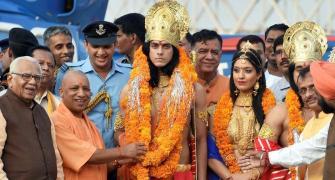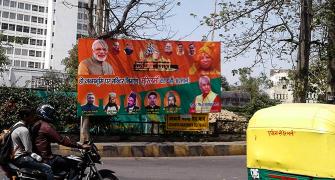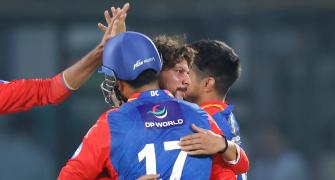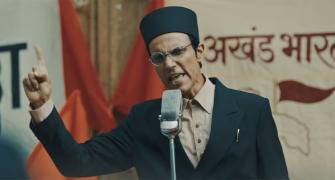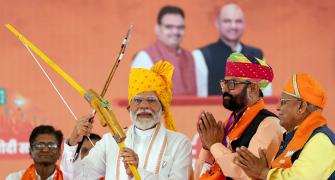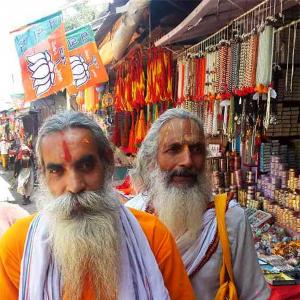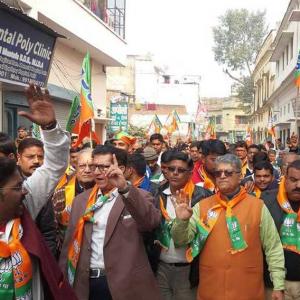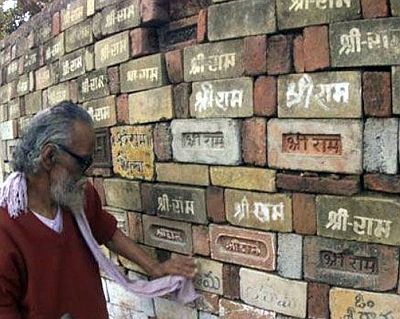 With the 2019 Lok Sabha polls less than eight months away, the party has resumed stoking the emotional issue through its second-and third-rung leaders, reports Virendra Singh Rawat.
With the 2019 Lok Sabha polls less than eight months away, the party has resumed stoking the emotional issue through its second-and third-rung leaders, reports Virendra Singh Rawat.
In October last year, a press communique by the Uttar Pradesh Ram Bhavan said the Yogi Adityanath government proposed to build a grand 100-metre Lord Ram statue near the banks of the river Saryu in Ayodhya.
A few days later, Chief Minister Yogi Adityanath, accompanied by a battery of his cabinet colleagues, descended on the temple town on the eve of Deepavali for a religious-cultural show comprising lighting diyas (earthen pots), performances by artistes from various parts of India and Southeast Asia, laser show themed on the Ramayan, etc.
Both these developments were deftly weaved around the party’s Ram temple agenda, which the ruling Bharatiya Janata Party has resorted to in successive elections, especially in the vast Hindi heartland. Uttar Pradesh has been the nerve centre of the temple movement and the ‘Kamandal’ theatre spearheaded by saffron outfits.
Now as the 2019 Lok Sabha polls are less than eight months away, the BJP has resumed stoking the emotional Ram temple issue through its second-and third-rung leaders although the top leadership has also and always sworn its commitment to the temple cause.
Recently, UP Deputy Chief Minister Keshav Prasad Maurya said the BJP-led central government could bring in a law to facilitate the construction of the temple if the Supreme Court verdict on the Ayodhya title suit was unfavourable.
Against the backdrop of the Adityanath government undertaking mega development and infrastructure projects over the past months to underline its socioeconomic commitment, the temple element seemed removed from the minds of the voters, especially the youth.
However, Maurya’s statement, which, political pundits say, is the first among the many more to come on the temple issue as elections draw nearer, serves two purposes for the party.
First, it brings the temple issue into the pre-election public discourse, and provides an opportunity to the saffron party to gauge the public mood and the reaction of opposition parties, so that any course correction could be incorporated into the larger election strategy.
Second, the prospects of opposition parties tilting at the election machinery of the BJP and the winning duo of Narendra Modi-Amit Shah have made the saffron party seek recourse to the emotive temple plank.
“The statement by Maurya shows the BJP is in a state of desperation, since 2019 would be fought in the name of Modi and the party is worried at the prospects of the election results, given the proposal of a grand alliance among regional parties. Plus, there is also the factor of anti-incumbency,” political analyst and commentator Sharat Pradhan said.
He said by introducing the temple element before the Lok Sabha polls, the BJP was trying to consolidate the majority vote, cutting across caste lines and splitting the traditional vote banks of its adversaries. Besides, the opposition parties would need to devise a response to the temple issue.
“The BJP knows the Centre cannot get any pro-temple law passed since it currently lacks a majority in the Rajya Sabha. Yet, it is making such statements to keep the Ayodhya issue contemporary while putting opposition parties on the defensive,” he underlined.
The recent passing of Atal Bihari Vajpayee has reinvigorated the party’s religious-cultural ethos. The ritual of immersing his ashes in Haridwar and other major places across India would provide an opportunity to the party to re-enforce the Hindutva line, albeit subtly.
During Deepavali, the party has planned similar high-optic events in Ayodhya. The religious-cultural thread will invariably extend to Kumbh Mela 2019, which will be just before the Lok Sabha elections and thus allow the party to showcase Hindutva elements under the garb of tourism initiatives.
Nonetheless, the BJP is deftly balancing the temple narrative with development showpieces, like the UP Investors Summit, One District One Product Summit, Bundelkhand Defence Corridor, Purvanchal Expressway, and Bundelkhand Expressway.
On anonymity, a BJP leader said the temple was a core issue for the party and it was confident of a pro-temple court verdict in consonance with the popular sentiments and the pro-temple stand taken by the Shia Waqf Board.
“It is wrong to suggest the party invokes the Ram temple issue for electoral gains. Besides, the ceremonies weaved around traditional festivals are aimed at introducing the new generation and the first-time voters to our ancient heritage, which was getting lost owing to the apathy of previous regimes,” he said.


